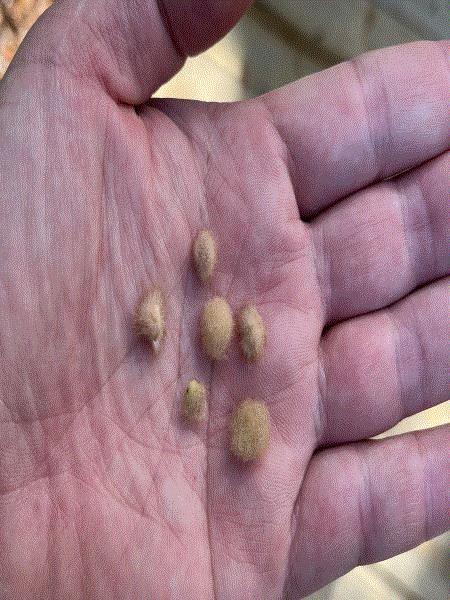What the ... ?
Before we get to today’s main topics, let’s play the “What the … ?” mystery game.
Fall is my favorite season in South Carolina. I don’t mind the heat and humidity of summer that much, but the cooler and drier air in the fall is always a nice reprieve.
I was doing the normal neighborhood patrol with my wife’s dog on Edisto Beach last weekend and we came across an interesting sight—there was a thick layer of small, light tan balls lying under the live oaks. When I picked them up I realized they’re fuzzy and more flattened like fluffy discs than spherical like balls. There's also an obvious “attachment point” of some kind on the fuzz balls.
What in the world are they?

More Insights on Lewis Mite Management
I chatted about the prevalence of Lewis mite infestation on this year’s poinsettia crop and how to manage them in the last issue of this newsletter. Dan Gilrein of Cornell Cooperative Extension reached out and shared some of his research and experience on managing Lewis mites. Thanks, Dan!
I’m going to briefly summarize some of Dan’s observations from several trials.
In a couple of trials targeting high mite population levels, Dan found Avid (4 fl. oz.; abamectin) and Akari (16 fl. oz.; fenpyroximate) to be highly effective, followed by Floramite (4 fl. oz.; bifenazate) and Shuttle O (31 fl. oz.; acequinocyl). Hexygon (4 fl. oz.; hexythiazox) was not very effective. (All application rates are on a per 100-gallon basis.)
In another trial, Dan again found Avid (4 fl. oz.) to be highly effective, but Pylon (2.6 and 5.4 fl. oz.; chlorfenapyr) to be only suppressive. Finding it odd, Dan repeated the trial and found the same result with Pylon.
In yet another trial, Dan once again found poor efficacy with Pylon, although Avid and Savate (2 and 4 fl. oz.; spiromesifen) were effective. I agree with Dan that the poor efficacy of Pylon was rather odd because Pylon did well in my small trial. Really, though, this kind of discrepancy isn’t unheard of in research. That’s why researchers always do lots of trials and compare notes among each other to see if the results lead to a general conclusion.

Is it Really Resistance?
Another interesting observation Dan shared with me is that a population on poinsettias he recently received from a grower (after the grower failed to control the Lewis mite population) seemed seriously difficult to control with Avid. In this trial, conducted by Jared Dyer (Dan’s associate at Cornell), Akari was still fairly effective, but not Avid. That prompted Dan to question whether there is indeed resistance or tolerance building up against abamectin.
I’d heard mumblings of resistance from several growers while dealing with Lewis mite this year. I was wondering, “Now, is it really resistance?” I can see y’all’s eyes rolling backward thinking, “Okay, here we go again. These responsibility-skirting pesticide salesmen.” (Some of them may think “scientist,” while doing air quotes. I’ll take that over salesman.)
Pesticide resistance, tolerance or reduced sensitivity (whichever term you like to use) isn’t the only reason for reduced pesticide efficacy. Using the wrong product or rate, targeting the wrong species or life stage, and not achieving sufficient spray coverage (because of low volume or using inappropriate nozzles, pressure or spray equipment, etc.) are common reasons for poor efficacy.
To have a product that was previously very effective but not working well this year, such as Avid in Dan’s example, is a troubling situation. Having listed all the possible reasons, if you’re sure you’d made the application correctly and have the same observation of poor efficacy confirmed by someone (like Dan and Jared) who conduct spray trials carefully (that is, avoiding all the common applicator errors), I think you can have a high level of suspicion on whether it’s indeed resistance or at least reduced susceptibility. This may be time for you to take a look at your own spray program and see where a product has been used a bit too frequently.
After ascertaining that your program hasn’t led to the situation, you may consider having a chat with your propagators about what they use on their stock plants or during propagation. The suspicion that resistance originated in propagation can be higher if many growers are having the same reduced efficacy of the same pesticide.
Are you having problems controlling Lewis mite this year and suspect resistance? Email me!

How Do You Confirm Resistance?
The observation that something's losing effectiveness isn’t strong evidence for resistance. Those observations stay in the realm of suspicions and may not be easily defended. (My wife will tell you I could easily argue against her even if I know I’m wrong.)
So how do you really confirm resistance?
The gold standard for many pest species is to run a carefully controlled experiment where the susceptibility (usually quantified as LC50 or the lethal concentration to cause 50% mortality in a population) of a “suspected resistant” population is compared to that of a “known susceptible” population. In some studies, researchers also compared the LC50 of a “suspected resistant” population to a “known resistant” population to quantify the level of resistance.
The “suspected resistant” population is the population where resistance needs to be confirmed. The “known susceptible” population is usually a population maintained in a laboratory for generations so that it’s susceptible to many miticides. A “known resistant” population is treated regularly to create or maintain resistance to (usually) a specific pesticide. This testing method can be used for any pesticides that are included in a pest management program. By testing these pesticides one by one, a researcher can find out which of the many products in a program the pest is resistant to.
This gold standard won’t be easily achieved with Lewis mite because, as I mentioned in the last newsletter, they're an occasional pest and no entomologist that I know of spends the time, energy and precious research funds on maintaining a susceptible colony that may be used once or twice in several years. We run trials on Lewis mite whenever we come across a population or two, which may have varying degrees of susceptibility. Without a susceptible population, you can’t compare its susceptibility to that of a suspected resistant population. Without that comparison, you don’t have confirmation.
Without confirmation with the gold standard methodology, we’ll have to aggregate observations or reports of suspected resistance from many growers to see if we can find some common trends. We may have a real problem if many growers have the same issue.
That’s quite enough experiment design talk for today. Let’s move on to something else ...

MSU’s Greenhouse Courses to Start in December
Michigan State University (MSU) Extension’s Online College of Knowledge greenhouse courses will start on December 1. Four courses are being offered: Abiotic Disorders of Greenhouse Crops; Greenhouse and Horticultural Lighting; Biological Control for Greenhouse Growers; and Floriculture Root Zone Management. These pre-recorded courses can be taken at any time and at your own pace between December 1, 2024, and March 15, 2025.
Credits received after completing two of the courses in this series count towards a Plant Health Professional Certificate under a collaboration between MSU and the University of Florida’s Greenhouse Online Training Program. These two courses are available in English and Spanish.

Registration deadline for MSU’s greenhouse courses is January 1, 2025. The cost for each course is $129. Three scholarships, which allow the winners to take each course at $39.99, are available.
Go HERE to register for the four MSU greenhouse courses.

Do You Grow Woody Ornamentals? Please Take This Survey
Do you propagate or produce woody ornamentals as a business? Researchers at The Ohio State University (OSU) are asking for your input in a survey designed to identify challenges, and research and extension needs in woody ornamental propagation.
The survey only takes five minutes, and participation is completely voluntary and confidential. A little bit of your time will help researchers and educators identify areas where they can help improve practices and techniques in woody plant propagation and production.
Go HERE to find out more and to take the survey. Email Garrett Owen and Olivia Liebing of OSU for questions, comments or concerns.
Answer on “What the … ?”
The fuzz balls or discs are the woolly oak leaf galls caused by tiny gall wasps. I've seen these galls frequently; I just haven’t seen them litter the ground.
There’s a large group of gall wasp species (from the family Cynipidae) that cause leaf and twig galls on oaks. (Go HERE for a fact sheet on Andricus quercuslanigera, which causes detachable woolly leaf galls on live oaks.) I’m not sure if what I saw is indeed the handy work of this particular species; I had better things to do that day (such as getting the dog home so I could have my coffee) than trying to collect the galls, keep them, wait until next spring, then identify the tiny gall wasps that emerge from the galls. (I mean tiny—like one-eighth of an inch tiny.) I had enough tiny wasp identification during my graduate school career to give me a pass on all future tiny wasp identification projects.
Despite my lack of interest in identifying the species, cynipid gall wasps (as a group in general) have a very interesting life history—different generations use different parts of a plant, which entomologists sometimes call alternation of generations. The galls I saw on the ground contain larvae, which will overwinter and produce a generation of adult wasps in the spring. The adult wasps will lay eggs on swollen buds; the hatched larvae will then cause some kind of physiological changes in plant tissues that result in woody galls on twigs. The woody galls will grow for the next two to three years, after which they'll produce another generation of adult wasps in the winter. This generation lays eggs in the buds and produces leaf galls in the next year.
I don’t usually recommend treating leaf and woody galls on mature trees. I would recommend treatment for young or newly transplanted trees because the twigs galls can really make a messy look, which may or may not be masked by more branches as the tree grows.
Unfortunately, I don’t really have consistently effective options for galls. Systemic insecticides didn’t seem to do much in reducing gall numbers. Although many insecticides are effective against adult wasps, it’s tricky to spray at the right time and spray to cover all the buds on large, tall trees. Spray on smaller trees is possible. For large, mature trees, if you can ignore the galls, ignore them. Treating them can just be an expensive hassle.


Happy Thanksgiving, y'all!

JC Chong
Technical Development Manager at SePRO
Adjunct Professor at Clemson University
This e-mail received by 27,847 subscribers like you!
If you're interested in advertising on PestTalks contact Kim Brown ASAP!